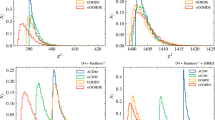Abstract
We examine the Poynting-Robertson (PR) effect under the influence of a logarithmic predicted as a correction to the Newtonian gravitational potential in the solar system. Our motivation emanates from the fact that today’s gravitational theories predict various corrections such that exponential, logarithmic to describe and understand the existence of dark matter, postulated to resolve discrepancies in astrophysical observations in today’s accepted theories of gravity. By saying that we simply mean that our main interest is to calculate the times that dust particles take to reach the Earth’s orbit and derive analytical expressions for the time changes of basic orbital elements in the influence of the PR effect. We use dust particle starting at a distance \(r = 2.7~\text{AU}\) or approximately in the asteroid belt. In a first order perturbation treatment we obtain time solutions for the orbital elements of semi major axis, eccentricity, and mean motion, as well as expressions for the time taken for these particles to reach Earth’s orbit. We find that for circular orbits in a logarithmic potential the time taken to reach Earth is slightly larger that the elliptical orbits. Newtonian potential circular orbits require more times when compared to the logarithmic ones. Finally elliptical orbits time to reach Earth are of the same order of magnitude with a dependence on the eccentricity, density, and particle diameter.





Similar content being viewed by others
References
de Pater, I., Lissauer, J.: Planetary Sciences 2nd edn. pp. 46–47. Cambridge University Press, Cambridge (2015)
Debono, I., Smoot, G.F.: General relativity and cosmology: unsolved questions and future directions. Universe 2(4), 23 (2016)
Diacu, F.N.: Report DMS-621-IR, University of Victoria (1992)
Fabris, J.C., Campos, J.P.: Gen. Relativ. Gravit. 41, 93 (2009)
Haranas, I., Mioc, V.: Poynting Robertson effect in a non singular potential. Astrophys. Space Sci. 331, 289–294 (2011)
Haranas, I., Ragos, O.: Yukawa effects in satellite dynamics. Astrophys. Space Sci. 331(1), 115–119 (2011)
Haranas, I., Ragos, O., Mioc, V.: Yukawa-type potential effects in the anomalistic period of celestial bodies. Astrophys. Space Sci. 332(1), 107–113 (2010)
Haranas, I., Ragos, O., Gkigkitzis, I., Kotsireas, I., Martz, C., Van Middekoop, S.: The Poynting-Robertson effect in the Newtonian potential with a Yukawa correction. Astrophys. Space Sci. 363, 3 (2018). https://doi.org/10.1007/s10509-017-3219-4
Haranas, I., Cobbett, K., Gkigkitzis, I., Alexiou, A., Cavan, E.: Modified Newtonian dynamics effects in a region dominated by dark matter and a cosmological constant \(\Lambda \). Astrophys. Space Sci. 365, 171 (2020)
Iorio, L.: Editorial for the special issue 100 years of chronogeometrodynamics: the status of the Einstein’s theory of gravitation in its centennial year. Universe 1(1), 38–81 (2015)
Jiménez, J.B., Heisenberg, L., Koivisto, T.S.: The geometrical trinity of gravity. Universe 5, 173 (2019)
Jung, C.H., Kim, Y.P.: Technical note: particle extinction coefficient for polydispersed aerosol using a harmonic mean type general approximated solution. Aerosol Sci. Technol. 41, 994–1001 (2007)
Kinney, W.H., Brisudova, M.: An attempt to do without dark matter. Ann. N.Y. Acad. Sci. 927, 127–135 (2001)
Kirillov, A.A.: Phys. Lett. B 632, 453 (2006)
Klacka, J., Kocifaj, M.: Times of inspiralling for interplanetary dust grains. Mon. Not. R. Astron. Soc. 390, 1491–1495 (2008)
Krugel, E.: An Introduction to the Physics of Interstellar Dust, pp. 74–75. CRC Press, Boca Raton (2007)
Lovell, A.C.B.: Meteor Astronomy. Clarendon Press, Oxford (1954)
Milgrom, M.: Astrophys. J. 270, 365 (1983)
Mioc, V., Blaga, P.: Rom. Astron. J. 1, 103 (1991)
Mücket, J.P., Treder, H.-J.: Astron. Nachr. 298, 65 (1977)
Murray, C.D., Dermott, S.F.: Solar System Dynamics p. 41. Cambridge University Press, Cambridge (1999)
Phillips, A.C.: The Physics of Stars. Wiley and Son, New York (1999)
Ragos, O., Haranas, I., Gkigkitzis, I.: Astrophys. Space Sci. 345, 67 (2013)
Salucci, P., Walter, F., Borriello, A.: \(\Lambda\text{CDM}\) and the distribution of dark matter in galaxies: a constant–density halo around DDO 47. Astron. Astrophys. 409(1), 53–56 (2003)
Sanders, R.H., Noordermeer, E.: Mon. Not. R. Astron. Soc. 379, 702 (2007)
Sanders, R.H., McGaugh, S.S.: Annu. Rev. Astron. Astrophys. 40, 263–317 (2002)
Skordis, C.: Phys. Rev. D 77, 123502 (2008)
Sparke, L.S., Gallagher, J.S. III: Galaxies in the Universe: An Introduction. Cambridge University Press, Cambridge (2007)
Vishwakarma, R.G.: Einstein and beyond: a critical perspective on general relativity. Universe 2(2), 16 (2016)
Walter, U.: Astronautics: The Physics of Space Flight, 3rd edn. p. 621. Springer, Berlin (2018)
Wyatt, S.P., Whipple, F.L.: The Poynting-Robertson effect on meteor orbits. Astrophys. J. 111, 134–141 (1950)
Acknowledgements
The authors want to thank an anonymous reviewer who with his comments helped improve this manuscript considerably.
Author information
Authors and Affiliations
Corresponding author
Additional information
Publisher’s Note
Springer Nature remains neutral with regard to jurisdictional claims in published maps and institutional affiliations.
Rights and permissions
About this article
Cite this article
Haranas, I., Gkigkitzis, I., Cobbett, K. et al. Poynting Robertson effects due to a logarithmic correction to the Newtonian potential. Astrophys Space Sci 366, 93 (2021). https://doi.org/10.1007/s10509-021-03998-4
Received:
Accepted:
Published:
DOI: https://doi.org/10.1007/s10509-021-03998-4




